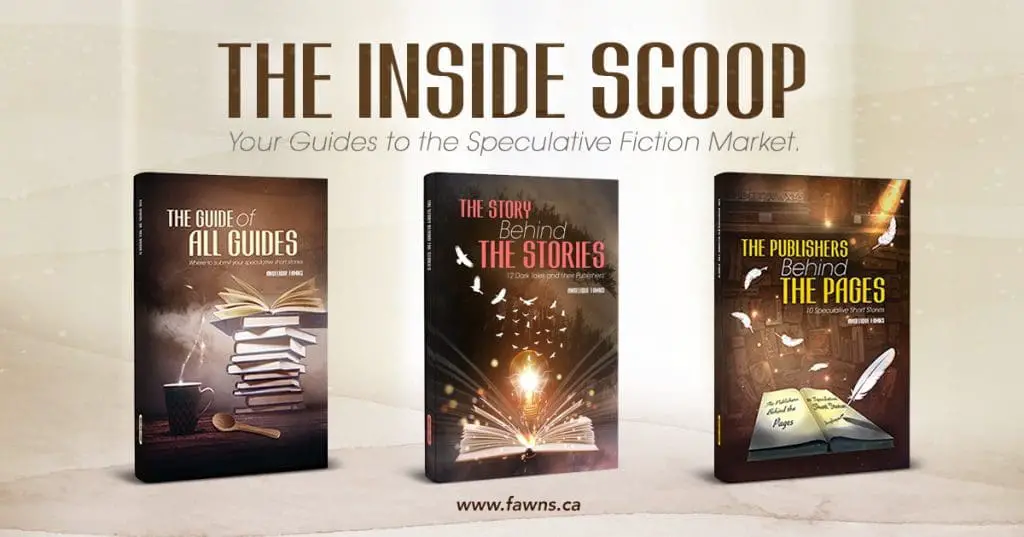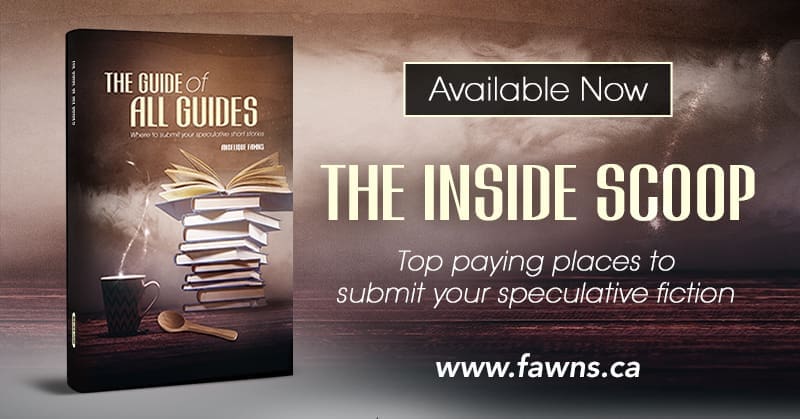Story Worms: An Interview with Angelique Fawns, Author of ‘The Guide of all Guides’

Finishing writing your short story might feel like the end of a long journey, but it’s also the beginning of a brand new one, too. And, for new and seasoned writers alike, the submission process can be a minefield of decisions, uncertainty, and simple fear. It can be a daunting step, and there are many writers who struggle to take it.
But, what if you could have all of the answers in your hand? The inside scoop on the various publishers and their pay rates? How about what the editors are looking for, or how long you’ll have to wait for a decision?
That’s exactly what you get with Angelique Fawns’ book, The Guide of All Guides.
 Angelique is a journalist and speculative fiction writer who started out writing articles about naked cave dwellers in Tenerife, and hosting a radio show in Mooloolaba, Australia. She now creates television commercials for Global TV in Toronto, and writes fiction in her spare time. Angelique lives on a farm north of the city with her husband, daughter, horses, goats, chickens, and a potcake rescue dog.
Angelique is a journalist and speculative fiction writer who started out writing articles about naked cave dwellers in Tenerife, and hosting a radio show in Mooloolaba, Australia. She now creates television commercials for Global TV in Toronto, and writes fiction in her spare time. Angelique lives on a farm north of the city with her husband, daughter, horses, goats, chickens, and a potcake rescue dog.
A prolific writer, Angelique has more than 30 short stories published across anthologies, magazines, and podcasts. Her stories have shared pages with the likes of Charlaine Harris and Piers Anthony. Penning tales of fantasy adventures, murder mysteries, zombie outbreaks, and horror carnivals, she is no stranger to any part of the speculative fiction spectrum.
I caught up with her to find out more.
How did you first start writing fiction, and what drew you to speculative fiction in particular?
I love being SCARED (when safe at home, of course). Edgar Allen Poe’s buried alive stories? Spine-chilling. Stephen King’s horrid clown? Excellent. Margaret Atwood’s dystopian world of misogyny? Soooo good. I always wanted to write my own fiction, but could never seem to find the time. Career building, marriage, a kid, riding horses, drinking wine with girlfriends… Before I knew it, I was 35 and only had one story published—a tale about alien invasion/possession involving beer. Then on May 28, 2018 I tripped over my 130lbs Cane Corso dog at midnight and broke my ankle. Four months of sitting still. I finally had time to write.
Which authors have most influenced you and your writing?
Ray Bradbury. He is diabolical. Isaac Asimov’s future visions about Robots. Margaret Atwood’s world building. George Orwell, Aldous Huxley, Emily St. John, Isacc Asimov, Kazuo Ishiguro… the list goes on and on. But what I really admire? Stephen King’s odd, yet believable characters and dang awesome dialogue.
What do you find so appealing about short fiction?
It’s better than a sleeping pill, shot of whiskey, or hammer to the head. Novels can keep you up all night. Read one short story, put the book down. Go to sleep.
What was the first short story you had published?
Not counting the beer-powered alien invasion piece published in 1991— My first story, Three Calendars, was picked up by Ellery Queen Mystery Magazine. It’s a Memento-style mystery with a twist ending.
What do you think are the benefits of mastering the short form? What can writers learn from it?
Imagine spending an entire year (or more) writing a novel and then deciding it’s terrible? Now that’s true horror. What I really like about writing short fiction is the speed of the process. You can write it, submit it, get rejected… rewrite it… get rejected… rewrite it…. and BINGO! It’s finally brilliant and accepted. Rejection letters from editors are so valuable if they give you feedback.
You’ve published a series of guides to selling short stories. What inspired you to write these books?
It’s a dark and stormy sea out there for us newbie writers! Full of sharks, scams, and lots of ways to waste our time and money. I gave away a lot of cash when I first started writing and had zero success. We’re talking more than 500 rejections and $1000 spent “paying to play.” Then I figured it out; 30 published stories and money coming in rather than out. My guides are supposed to be life rafts. A way to help new writers avoid drowning. I decided to interview editors and publishers to help me learn the industry. The stuff I got was so fabulous I had to share. I’m amazed by how candid and honest people can be. Many of my publisher interviews are posted here on Horror Tree.

If someone is looking to start selling short stories, what’s the very first thing they should be doing?
Figure out what your ultimate goal is. Do you want to publish literature and make a difference? Looking for the kudos of winning a contest? Is this just a hobby and you don’t mind publishing for free? Are you trying to use short stories to build a resume for your future novel?
I wasted so much time and money in the summer of 2018 when I first started submitting. Originally, I was sending my short fiction to contests and literary magazines. Almost all of them had “entry” or “reading” fees. The turnaround time could be very long. Though I received a few honorable mentions, I had nothing published, received very little feedback, and spent almost $1000. This was the wrong path for me. I wanted to: Make money; not spend it. Hear back quickly; not have a story stuck in purgatory for a year. Get feedback. Genre markets—accepting free submissions—is more my style.
And what’s the most important thing for writers to remember when submitting stories?
Research the magazine, anthology, or podcast before submitting! Editors are looking for very specific things, and normally have stringent guidelines for how they want to see your work. It wastes everybody’s time if you submit blindly. Plus, there’s very little chance you will sell anything.
What can people learn from your latest book, The Guide of All Guides?
They can learn instantly what took me years to learn. The Guide of All Guides features over 65 markets that PAY, giving insight into what the editors are looking for. It tells writers the names of the current editors, the history of the market, what kind of stories they buy, average turnaround time, and even includes actual rejection letters.
What’s up next for you as a writer?
I’ve recently had two stories picked up “on condition of revision” by pro markets. “Invasive Species” by DreamForge Anvil, and “The Patron Saint of Livestock” by Cosmic Roots & Eldritch Shores. (“Invasive Species” was rejected 33 times, and completely rewritten 8 times before finding a home.) I’m in the midst of working through some very insightful rewrites with the editors. I LOVE this part of the process. I’m also working on the third installment in my “Selling Stories” Series: The Publishers Behind the Pages.
First, I wrote The Story Behind the Stories, an anthology featuring 12 of my tales with insights and secrets from the publishers who bought them. The Guide of All Guides was supposed to be a “companion piece” but kept growing and growing until it was over 200 pages long and chock full of information. The Publishers Behind the Pages picks up where the first anthology left off and is being released in May. It features ten more speculative stories and does a deep dive with the editors who bought them.
You can find out more about Angelique and her books at www.fawns.ca. She is also on Facebook and Twitter.

The Guide of All Guides by Angelique Fawns
You’ve written your short story. Now where do you send it?
This guide lists the TOP paying places for speculative fiction. Get all the details you to need to maximize your chances for success. Learn what editors are looking for. Understand the market. Read REAL rejection letters.
These magazines, ezines and podcasts are paying for stories. Get the inside scoop!
- About the Author
- Latest Posts
Angeline Trevena is a British author of dystopian urban fantasy and post-apocalyptic fiction. She has an impressive backlist of novels, a series of worldbuilding guides for authors, and short stories appearing in various anthologies and magazines. Despite the brutal and dark nature of her fiction, Angeline is scared of just about everything, and still can’t sleep in a fully dark room. She goes weak at the sight of blood, can’t share a room with a spider, but does have a streak of evil in her somewhere. Find out more at www.angelinetrevena.co.uk












